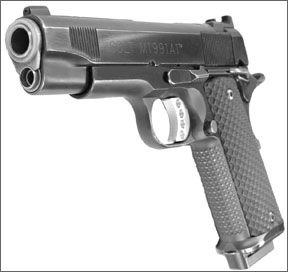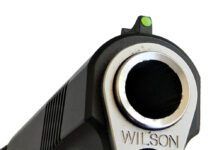In the April 2009 issue, our test team shot and evaluated three high-end custom full-size 1911s: the Combat Custom, $2895, from Luke Volkmann of Volkmann Custom Inc.; Wilsons CQB, $2550, and Les Baers Premier II Super-Tac, $2280. Attempting to pick the best one was anything but easy. They were all excellent. But we graded the Wilson CQB as the best of that trio.

At the same time we also shot and evaluated a fourth product, but held back the test data for this special report because the gun was massively more expensive and harder to get than the other three. This follow-up will cover a Michiguns 45 Commander Custom, about $5000, available from Ned Christiansen. If you want a gun from Michiguns, be prepared to wait five or six years. Christiansens innovative touches and incredible machining skills (hes a one-man shop) have vaulted him to the top echelon of gunsmiths, with a resultant huge backlog.
As before, we tested with four types of ammunition, Black Hills hardball, Federal 185-grain Hi-Shok JHP, Cor-Bon 230-grain JHP, and with cast-lead, 230-grain round-nose Ultramax. We tested during a severe winter in Idaho, and thus had trouble achieving the guns full accuracy potential. With the Federal 185-grain JHPs, the Commander bested the CQB slightly, with an average group size of 1.5 inches to 1.6 inches. The margin was a little wider with the Cor-Bon 230-grain JHPs, with the Commander shooting average group sizes of 1.4 inches compared to the CQBs 2.0-inch average. The measurements with the Ultramax 230-grain cast roundnose had the Commander in front 1.4 inches to 1.7 inches, and likewise for the Black Hills 230-grain ball, 1.3 inches to 1.6 inches. All were five-shot groups fired at 15 yards.
Before you read deeper into this article, we know of course that youre wondering how this fairly standard-looking Commander could possibly fetch such a price as the “about $5000” listed a few lines down. We assure you the reasons are not quickly seen, but close examination led us to the conclusion Christiansen didnt charge enough for what he did. Some of his work cant be appreciated unless you have a normal 1911 on hand to compare. All of his work was extraordinary, the best workmanship our Idaho test team has seen.Michiguns 45 Commander Custom, about $5000
The first thing one notices is the grip treatment. The forward strap and mainspring housing have what Michiguns (www.m-guns.com) Ned Christiansen calls Conamyds, sort of like cone-shaped pyramids. There are 119 of them precisely machined into the front strap, and between each is a tiny diamond. The precision of their placement and fineness of their execution are details not often seen on any firearm, no matter the price. The Conamyds begin and end precisely at the edge where the grips flat side breaks into the curved front portion. The pattern is repeated on the mainspring housing, which itself was made entirely from scratch out of 7075 aluminum.
Its fit into the frame is such that the joint is invisible to the naked eye, and difficult to see even with 5x magnification. The housing includes a small lanyard slot. The Conamyd pattern is also repeated on the bottom portion of the grip safety, shows up in a smaller size under the slimmed and re-contoured trigger guard, and is on the top and bottom of the slide stop. The pattern is also on the tip of the magazine release. These patterns are in no case hammered in. They are precisely and carefully machined in, and spaced to fit the available area.
The grip panels had a strong pattern of concave holes that gave outstanding traction to the hand, almost too much. They are the Simonich Knives LLC Gunner Grips, and are hiding some weight-reduction holes put into the frame by Christiansen. The custom mainspring housing and relatively thin grip panels resulted in a noticeably smaller grip, giving the gun a well-balanced feel.
There were serrations cut into the front of the slide to permit press checking, but they didnt just slice through the side of the slide. They stopped short of the bottom edge, and their terminations followed the contour of the slide. The top rib was formed by machining away metal from the curved top of the slide and leaving a flat area for most of the length of the slide. That flat area was then machined with what used to be known as a file-cut surface, yet the lines of the cuts stopped short on each side, forming a crosshatched non-glare pattern in the central portion of the rib. Christiansen admitted he would not happily again do such a job, and also said it was all done on a simple Bridgeport mill with custom cutters. There are no cutter or milling marks anywhere on the gun except those left intentionally.
The sight pattern was what the customer ordered, and it was horrid. It was experimental, didnt work out as planned, and was the reason why this loaner gun was made available to us for test and evaluation. The owner sent it back for sight modification. One thing we didnt like, next to the oddball sight picture, was the fact that the rear sight would badly cut your hands in a stovepipe drill. This sight was made at the customers request to permit one-handed racking of the slide in an emergency. The rear sight would hook your belt, door jamb, etc. We didnt like that feature at all, and were assured it would be changed.
Christiansen has to be excused for this because he gave his customer exactly what was wanted, but it must be said it will cut your weak hand to doll rags on a stovepipe drill.
The safety was not easy to put on, but it stayed securely wherever it was put. The ambidextrous lever was relieved so it didnt bite the knuckle, and the right-side safety lever had positive stops at the on and off positions to avoid needless wear on the connecting joint. The safety levers had the serrations extended around the end, and there was checkering underneath. The trigger had four holes, not three. The magazine well was hand made from scratch and tig-welded into place on a suitably shortened grip to give the normal grip length. The trigger pull was 4.2 pounds, and the trigger was set for minimal overtravel without the use of a screw.
Takedown was done by aligning the cut in the slide with the cross pin and pressing the pin out. The full-length spring rod, put on at the customers request, remained in the slide until it was pressed forward, secured with a paper clip, and withdrawn rearward. Inside the frame there were lightening holes cut into the area under the feed ramp and downward into the top of the trigger-guard bow. Reassembly was straightforward.
We learned that on all his future guns (and this one when its returned), Christiansen will use “Tungsten DLC” finish, a hard electro-deposited type. This and future guns will also get Christiansens Michiguns logo.
Wed like to see engraving on his handguns, but thats a personal thing with us, and would add to the cost. Yet the workmanship on Christiansens gun is worthy of comparison to the finest English double rifle, and those all carry engraving by necessity, just like a bow tie is necessary to mens formal wear. Michiguns pistols are undoubtedly lifetime guns. They will rarely, if ever, be sold, and as such stand alone in the firearms world. There were no surprises on the range.
The Michiguns Commander 45 ACP worked perfectly and gave accuracy equal to the best, with a slight preference for hardball in our limited testing. The results would have been easier to achieve with a better sight picture. So are all these mods necessary? No, of course not. But for an extremely personal, one-off firearm for the shooter who can afford the time and the cost needed to invest in such a product, we doubt theres any better place to go than Ned Christiansen and his Michiguns.
0509-Michiguns-45-Commander.pdf


















